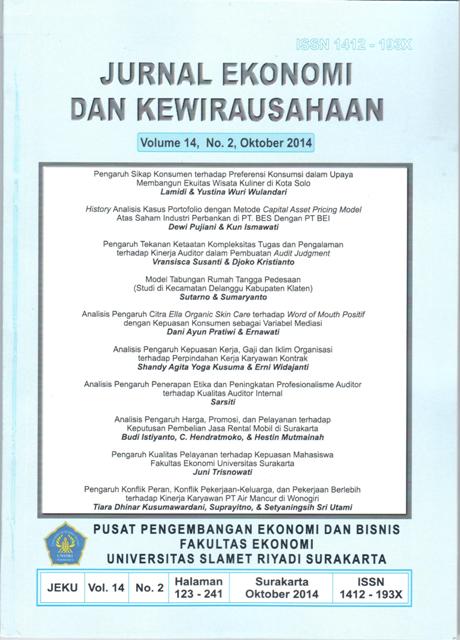MODEL TABUNGAN RUMAH TANGGA PEDESAAN (STUDI DI KECAMATAN DELANGGU KABUPATEN KLATEN)
Abstract
This research aims to estimate the model of rural households in savings Delanggu sub-district Klaten district. It is also to identifying variables impact on savings rural households. The population is all households which consisted of 14.620 rural households or dwell in the sub-district of Delanggu. Taken as much as 94 sample of households use the technique of a two stage clusters of sampling, with the village used as a group. The data in this study is the primary data collected through the survey by using a list of questions that have been prepared. The process of analysis for this research using model log-linear. The results of the analysis show: (1) An log-linear used in this research are good models. (2) There were three variable influence significantly to households savings. Based on test performed: (1) An hypothesis is first permanent revenue give positive effect on saving prove true. (2) Hypothesis both the higher revenues while the household savings will increase not prove true. (3) the third hypothesis is higher age householder and household savings are increasing not prove true. (4) a hypothesis that is the fourth high education levels householder and household savings are increasing not prove true. (5) hypothesis is the fifth household savings differ between species of different jobs prove true. (6) hypothesis sixth namely. dependency ratio hence higher household saving to decline prove true. (7) hypothesis is the seventh household savings differ among households have credit and credit not have not proved the truth. (8) Hypothesis eighth namely the size of the savings different households between of households that have insurance and who do not have insurance not prove true. Keywords: Saving, Household, RuralDownloads
Published
2015-01-07
Issue
Section
Artikel
License
Authors who publish this journal agree to the following terms:
- Authors retain copyright and grant the journal right of first publication with the work simultaneously licensed under a Creative Commons Attribution License that allows others to share the work with an acknowledgement of the work's authorship and initial publication in this journal.
- Authors can separately make additional contractual arrangements for non-exclusive distribution published by the journal (e.g., publish it in a book), with an acknowledgement of its initial publication in this journal.
- Authors are allowed and encouraged to send their work via online (e.g., in the institutional repositories or their website) after published by the journal.









